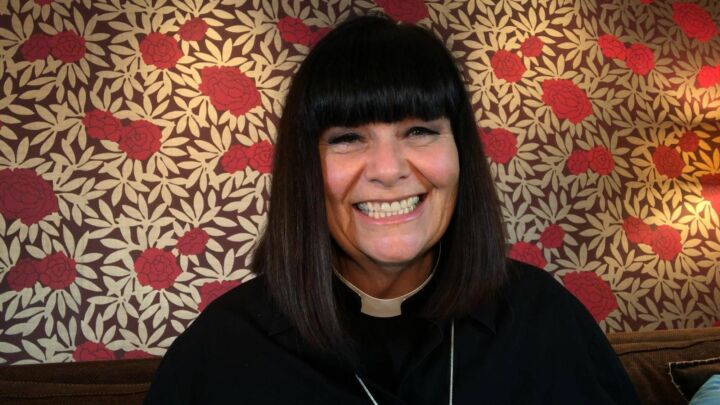All the table’s a stage
From TV chefs to DIY shows, UK lifestyle programmes have moved further and further away from the hobbies they are supposed to be talking about. Why?

On a weekday evening’s channel-hopping, you would expect to find at least one cookery show or DIY programme on UK TV. A recent analysis of BBC1 discovered that ‘hobbies and leisure, quiz shows and features’ had shot up from three percent of peak time scheduling in the 1970s to 27 percent in 2000, while drama had halved to 11 percent.
As celebrity cooks and DIY experts like Ainsley Harriot and Charlie Dimmock are becoming ever-more present on screen, not only do their programmes become everyday talking-points, but so do their lifestyles. Jamie Oliver, the fashionably-clad Mockney presenter of The Naked Chef, has attempted a doomed pop music career. The distinctive interior designer, Laurence Lewellyn-Bowen of Fantasy Rooms fame, enjoys regular coverage in newspaper supplements. And the domestic goddess, Nigella Lawson, is envied in conversation and in copy for her ability to balance housewife bliss with TV appearances, a best-selling cookbook and highbrow column inches.
What is it about lifestyle interests that have produced this current preoccupation on TV? To some extent, cooking and DIY are bound to appeal because they are colourful, varied and relate to the experiences of a wide audience. When Changing Rooms arrived on the scene, its fresh approach to the traditional DIY show, where the producers showed people openly expressing their hate for the finished result, was welcomed. Cookery shows broke the mould (quite literally in some cases) with lively young chefs revealing the cherished tricks of their trade and provoking thousands of us to be more adventurous with our groceries.
But as these new formats have expanded, lifestyle programmes have moved further away from the hobbies they are supposed to be talking about. Delia Smith hangs in there with How to Cook, teaching you basic cooking skills and getting you into the kitchen; but most TV chefs seem to be more interested in cooking up guidelines for a good social life.
With the new kids on the block, cooking is less about the food you eat than the friends you invite around for dinner. Jamie Oliver’s show depicts this young-and-beautiful man preparing dinner for his young-and-beautiful friends. He prefers marital banter with his wife on the phone to talking about measurements and ingredients. When esteemed UK cook Gary Rhodes talks to his dining companions about his delightful chocolate mousse, he does it around a candle-lit oak table with gentle lounge music in the background. All the table’s a stage, contrived to show that cooking can win you friends and influence people.
Less interesting areas of life have also tried to capitalise on the preoccupation with domesticity. Lloyds Bank’s recent advertising campaign asks, ‘If you could bank a smell, what would it be?’. How about the smell of crisp new fivers and tenners, please? The advertising gurus clearly think that if you put pictures of food on your advertisements, people will confuse financial planning for cookery recipes.
Maybe they are on to something. Lifestyle TV has been inspired by real changes in people’s buying patterns. A wider variety of food and wine is available in local supermarkets. More and more people redecorate and can afford to think about design in their homes (the home furnishings store IKEA opened 20 new shops in the UK last year to accommodate the growing market). And a boom in design can be no bad thing. In the 1950s, DIY shows (though fewer in number than now) reflected the real optimism and consumer choice that people had after the war, and the bold use of colour favoured by designers of that time symbolized an attempt to break out of war gloom, and enjoy the pleasures of setting up home in newly developing towns.
But there were no misconceptions then, and there should be none now. The domestic sphere will not bring you fulfillment. As interior design was really taking off in the 1960s, women were fighting to get out of their homes and enter public life. Now, by contrast, it seems that as a nation we have retreated into our domestic worlds more than ever.
It wasn’t so long ago that the viewing public escaped from the dull routine of everyday life by tuning to glitzy American soap operas like Dallas and Dynasty. While these were in no way quality dramas, the balance of prime-time TV viewing in the 1980s showed that the public wanted to be entertained by a faraway world of diamonds, glamour and beautiful people.
Now it is the ordinary world of kitchen chores that is being hailed as the ‘good life’. The domestication of the nation’s tastes has become so banal that we are content to watch, as voyeurs, a middle-aged woman on Changing Rooms cry for joy at her new dining room. Is a newly decorated room really that exciting? Especially when it is not even our rooms that have been changed, but those belonging to somebody we do not know.
Some commentators have blamed today’s preoccupation with lifestyle TV on increasingly tight budgets and the temptation to produce programmes with low production costs. Cookery, DIY and hobby programmes are cheaper to make because they do not require script-writing or acting fees. However, our mainstream cultural life suffers not only because of the shallow pockets of TV executives, but because of their shallow imaginations too.
There is a real reluctance in the TV hierarchy to develop innovative new programmes and drama for mass audiences. As long as domesticated TV reigns supreme, our fascination with the banal will surely continue.
To enquire about republishing spiked’s content, a right to reply or to request a correction, please contact the managing editor, Viv Regan.







Comments
Want to join the conversation?
Only spiked supporters and patrons, who donate regularly to us, can comment on our articles.